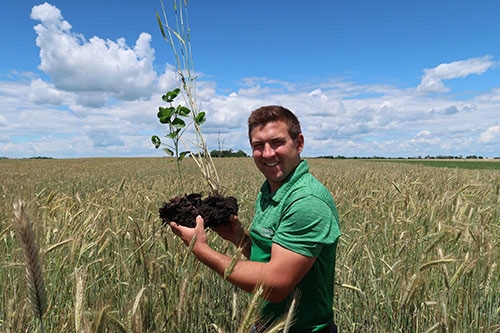You are here
Home ›RC&D’s Multi-Cropping Initiative part of American Flood Coalition’s first ever Grantee Cohort

Producer Mitchell Hora, in photo above, inspects soil aggregate in his field multi-cropped with soybeans and rye. Submitted photo.

A field in Northeast Iowa, pictured above, that has been multi-cropped with winter wheat and soybeans. Submitted photo.
Northeast Iowa RC&D has been announced as one of three members of an elite place-based flood prevention model made possible through the American Flood Coalition (AFC). The RC&D along with the two other awardees, The Coalition for Environment, Equality, and Resilience in Harris County Texas, and the Wetlands Watch in Norfolk, Virginia, was recognized for its efforts in providing scalable solutions to help prevent the devastation from flooding experienced around the US. As part of this recognition, AFC will work with each of these organizations over the next year to test their strategies for flood reduction in order to document workable solutions that can be adopted throughout the US and inform national policy development.
“The American Flood Coalition is thrilled to support and amplify the important work of our local grantees,” said Melissa Roberts, Executive Director of the American Flood Coalition. “These organizations are true innovators, developing solutions to flooding in communities from Harris County, Texas, to Southern Virginia to Northeast Iowa. We look forward to learning from them and connecting their work to our broader efforts in Washington, D.C. and across the country.”
The American Flood Coalition is a newly formed non-partisan non-profit composed of cities, elected officials, military leaders, businesses, and civic groups that describes their goal as coming together to “drive adaptation to the reality of higher seas, stronger storms, and more frequent flooding through national solutions that support flood-affected communities and protect the nation’s residents, economy, and military installations.”
The RC&D’s work for this group will focus on the use of multi-cropping, a regenerative agriculture practice in which farmers plant and harvest more than one crop from a field in the same year, as a means of flood reduction. Over the past three years, the RC&D has been working to demonstrate the multiple benefits of this innovative practice including how it improves soil health and affects profitability. The soil health component will be the main focus of the RC&D’s project with AFC as they work to measure the water carrying capacity and thereby flood reduction potential of fields being multi-cropped.
Ross Evelsizer, the RC&D’s Multi-Crop Iowa Project Director stated, “Multi-cropping is the closest thing to a silver bullet we see for dealing with agricultural issues right now. It addresses low commodity prices, higher inputs costs, conservation, and sustainability. It’s gaining recognition not just here in Iowa but around the world for its incredible potential. Many Iowa producers and organizations are leading the charge to make the case for multi-cropping and we’re thrilled to be part of this change. We’ve been working on multi-cropping for a couple years and seen it work for producers. Now we also want to document how landscape-based changes can mitigate the severity of increased rainfall for our residents and communities.”
The project will take place over the course of the 2021 growing season. The RC&D will measure soil moisture, evapotranspiration, rainfall, and monitor tile flow on a research farm in Northeast Iowa to compare regenerative agriculture fields to conventional practices. The data will be shared with the Iowa Flood Center who will use existing watershed models to evaluate the hydrologic impacts at a watershed scale.
“In Northeast Iowa, the RC&D’s efforts over the last ten years to help plan for and implement watershed resiliency strategies have helped bring in millions of dollars to the region to protect our communities and improve our water quality,” said Paul Berland, Northeast Iowa RC&D Executive Director. “Through dozens of valuable partnerships with local SWCDs, counties, communities, producers, conservation boards, NRCS offices, the Iowa Soybean Association, and the Iowa Flood Center, we’ve been able to document the impact these strategies are having on flood reduction as well as the improvement in water quality. There’s more work to be done and we are pleased to be part of this group. We are honored to work with the American Flood Coalition and hopeful that these ideas will make a difference.”
For more information on this project and other multi-cropping projects, visit northeastiowarcd.org/multi-crop or email Ross at ross@northeastiowarcd.org.

